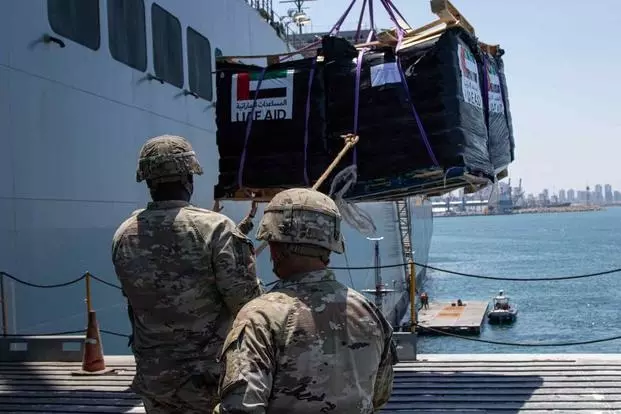Over 569 metric tons of humanitarian aid have arrived in Gaza via a US-built floating pier; however, none has been distributed to Palestinian civilians as of yet.

The structure was constructed by the US Army to alleviate the severe humanitarian crisis in the conflicted region and completed last Thursday.
Despite the successful transportation of supplies across the pier, several trucks carrying food and other essential items have reportedly been intercepted upon reaching Gazan mainland.
Pentagon Press Secretary Air Force Maj.
Gen.
Pat Ryder informed reporters that assistance was indeed being delivered to Gaza but not yet distributed to Palestinians.
The aid is expected to reach the affected population in due course, given favorable conditions.
When questioned about the actual delivery of supplies as of Tuesday, Ryder responded, “I do not believe so.” Some trucks operated by non-governmental organizations (NGOs) responsible for delivering the aid were reportedly raided by looters during transportation.
Some of that initial aid that was brought in, as it was being taken along a transportation route, was intercepted by some people who took that aid off those vehicles,” explained Ryder.
Subsequently, there’s been discussions by which to ensure that there’s alternate routes so that it can be delivered to warehouses.
The Associated Press reported that on Saturday, the United Nations World Food Program (UNWFP), an NGO involved in the intricate logistics process, attempted to transport aid from the beach to a warehouse using 16 trucks.
However, only five of them reached their destination, with the remaining 11 allegedly “commandeered” by a mob and one Palestinian being shot dead during the confrontation.
The complex distribution system involves humanitarian supplies being shipped from Cyprus to the floating pier first.
From there, US military personnel transport the aid to a causeway connecting the pier to the mainland.
Non-US contractors then move the supplies onto shore and assemble them in an area designated for distribution.
NGOs then collect pallets containing essential items for delivery to warehouses, from which they are supposed to be distributed to civilians in need.
Addressing the issue of violence during aid transportation, Ryder stated, “When it comes to the security of NGOs, that’s a decision that they all make internally.” He added that the amount of aid being distributed is expected to increase with time, urging patience.
We’ve been very clear from the beginning that we’re going to take a crawl, walk, run approach to make sure that we are implementing this system in a way where we’re working out the processes, the procedures, including taking into account the security conditions,” explained Ryder.
So I think you’re going to see, as we work together, the amount of aid increase and the ability to get it distributed increase.
He acknowledged that the situation is challenging but expressed confidence in the distribution plan’s effectiveness over time.
The temporary port was announced by President Biden during his State of the Union address in March, with the floating pier allowing food, water, medicine, and temporary shelter to reach the besieged Hamas-run enclave “every day.
